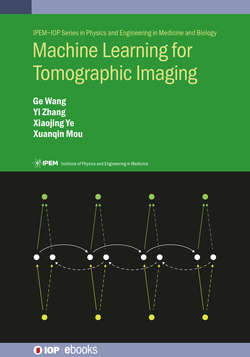Machine Learning for Tomographic Imaging

Реклама. ООО «ЛитРес», ИНН: 7719571260.
Оглавление
Professor Ge Wang. Machine Learning for Tomographic Imaging
Contents
Editorial Advisory Board Members
Foreword
Preface
Acknowledgments
Author biographies
Introduction
0.1 Artificial intelligence/machine learning/deep learning
0.2 Image analysis versus image reconstruction
0.3 Analytic/iterative/deep learning algorithms for tomographic reconstruction
0.4 The field of deep reconstruction and the need for this book
0.5 The organization of this book
0.6 More to learn and what to expect next
References
IOP Publishing. Machine Learning for Tomographic Imaging. Ge Wang, Yi Zhang, Xiaojing Ye and Xuanqin Mou. Chapter 1. Background knowledge. 1.1 Imaging principles and a priori information. 1.1.1 Overview
1.1.2 Radon transform and non-ideality in data acquisition
1.1.3 Bayesian reconstruction
1.1.4 The human vision system
1.1.5 Data decorrelation and whitening
1.1.6 Sparse coding
References
IOP Publishing. Machine Learning for Tomographic Imaging. Ge Wang, Yi Zhang, Xiaojing Ye and Xuanqin Mou. Chapter 2. Tomographic reconstruction based on a learned dictionary. 2.1 Prior information guided reconstruction
2.2 Single-layer neural network
2.2.1 Matching pursuit algorithm
2.2.2 The K-SVD algorithm
2.3 CT reconstruction via dictionary learning
2.3.1 Statistic iterative reconstruction framework (SIR)
2.3.2 Dictionary-based low-dose CT reconstruction
2.3.2.1 Methodology
2.3.2.2 Experimental results
2.4 Final remarks
References
IOP Publishing. Machine Learning for Tomographic Imaging. Ge Wang, Yi Zhang, Xiaojing Ye and Xuanqin Mou. Chapter 3. Artificial neural networks. 3.1 Basic concepts
3.1.1 Biological neural network
3.1.2 Neuron models
3.1.3 Activation function
Sigmoid
Tanh
ReLU
Leaky ReLU
ELU
3.1.4 Discrete convolution and weights
A special convolution: 1 × 1 convolution
Transposed convolution
3.1.5 Pooling strategy
3.1.6 Loss function
Mean squared error/L2
Mean absolute error/L1
Mean absolute percentage error
Cross entropy
Poisson
Cosine proximity
3.1.7 Backpropagation algorithm
3.1.8 Convolutional neural network
History
Architecture
Distinguishing features
A CNN example: LeNet-5
3.2 Training, validation, and testing of an artificial neural network
3.2.1 Training, validation, and testing datasets
3.2.2 Training, validation, and testing processes
3.2.3 Related concepts
Gradient management
Overfitting
Batch normalization
Dropout
Early stopping
Pruning
Data argumentation
3.3 Typical artificial neural networks
Auto-encoder
‘Bottleneck’ architecture
Some details of the auto-encoder
Typical auto-encoders
3.3.1 VGG network
VGG architecture
Key points of the VGG
3.3.2 U-Net
U-Net architecture
Some details of U-Net
Key points of U-Net
Variants of U-Net
3.3.3 ResNet
Degradation of deep networks
Residual learning
ResNet architecture
Variants and interpretation of ResNet
3.3.4 GANs
Discriminative versus generative models
GAN principle
Variants of GAN
3.3.5 RNNs
What is RNNs?
How to train RNNs?
RNN extensions
3.3.6 GCNs*
The fundamentals of GCNs
References
IOP Publishing. Machine Learning for Tomographic Imaging. Ge Wang, Yi Zhang, Xiaojing Ye and Xuanqin Mou. Chapter 4. X-ray computed tomography
4.1 X-ray data acquisition. 4.1.1 Projection
4.1.2 Backprojection
4.1.3 (Back)Projector
4.2 Analytical reconstruction. 4.2.1 Fourier transform
4.2.2 Central slice theorem
4.2.3 Parallel-beam image reconstruction
4.2.4 Fan-beam image reconstruction
4.2.5 Cone-beam image reconstruction∗
4.3 Iterative reconstruction. 4.3.1 Linear equations
4.3.2 Algebraic iterative reconstruction
4.3.3 Statistical iterative reconstruction
4.3.4 Regularized iterative reconstruction∗
4.3.5 Model-based iterative reconstruction
4.4 CT scanner. 4.4.1 CT scanning modes
4.4.2 Detector technology
4.4.3 The latest progress in CT technology. 4.4.3.1 Interior tomography
4.4.3.2 Multi-spectral CT
4.4.4 Practical applications. 4.4.4.1 Medical applications
4.4.4.2 Industrial applications
4.4.4.3 Other applications
References
IOP Publishing. Machine Learning for Tomographic Imaging. Ge Wang, Yi Zhang, Xiaojing Ye and Xuanqin Mou. Chapter 5. Deep CT reconstruction. 5.1 Introduction
5.2 Image domain processing
5.2.1 RED-CNN
5.2.2 AAPM-Net
5.2.3 WGAN-VGG
5.3 Data domain and hybrid processing
5.4 Iterative reconstruction combined with deep learning
5.4.1 LEARN
5.4.2 3pADMM
5.4.3 Learned primal–dual reconstruction
5.5 Direct reconstruction via deep learning
References
IOP Publishing. Machine Learning for Tomographic Imaging. Ge Wang, Yi Zhang, Xiaojing Ye and Xuanqin Mou. Chapter 6. Classical methods for MRI reconstruction
6.1 The basic physics of MRI
6.2 Fast sampling and image reconstruction
6.2.1 Compressed sensing MRI
6.2.2 Total variation regularization
6.2.3 ADMM and primal–dual
6.3 Parallel MRI*
6.3.1 GRAPPA
6.3.2 SENSE
6.3.3 TV regularized pMRI reconstruction
References
IOP Publishing. Machine Learning for Tomographic Imaging. Ge Wang, Yi Zhang, Xiaojing Ye and Xuanqin Mou. Chapter 7. Deep-learning-based MRI reconstruction
7.1 Structured deep MRI reconstruction networks
7.1.1 ISTA-Net
7.1.2 ADMM-Net
7.1.3 Variational reconstruction network
7.2 Leveraging generic network structures. 7.2.1 Cascaded CNNs
7.2.2 GAN-based reconstruction networks
7.3 Methods for advanced MRI technologies. 7.3.1 Dynamic MRI
7.3.2 MR fingerprinting
7.3.3 Synergized pulsing-imaging network
7.4 Miscellaneous topics* 7.4.1 Optimization with complex variables and Wirtinger calculus
7.4.2 Activation functions with complex variables
7.4.3 Optimal k-space sampling
7.5 Further readings
References
IOP Publishing. Machine Learning for Tomographic Imaging. Ge Wang, Yi Zhang, Xiaojing Ye and Xuanqin Mou. Chapter 8. Modalities and integration
8.1 Nuclear emission tomography
8.1.1 Emission data models
8.1.2 Network-based emission tomography
8.2 Ultrasound imaging
8.2.1 Ultrasound scans
8.2.2 Network-based ultrasound imaging
8.3 Optical imaging
8.3.1 Interferometric and diffusive imaging
8.3.2 Network-based optical imaging
8.4 Integrated imaging
8.5 Final remarks
References
IOP Publishing. Machine Learning for Tomographic Imaging. Ge Wang, Yi Zhang, Xiaojing Ye and Xuanqin Mou. Chapter 9. Image quality assessment
9.1 General measures
9.1.1 Classical distances
9.1.2 Structural similarity
9.1.3 Information measures
9.2 System-specific indices
9.3 Task-specific performance
9.4 Network-based observers*
9.5 Final remarks*
References
IOP Publishing. Machine Learning for Tomographic Imaging. Ge Wang, Yi Zhang, Xiaojing Ye and Xuanqin Mou. Chapter 10. Quantum computing*
10.1 Wave–particle duality
10.2 Quantum gates
10.3 Quantum algorithms
10.4 Quantum machine learning
10.5 Final remarks
References
IOP Publishing. Machine Learning for Tomographic Imaging. Ge Wang, Yi Zhang, Xiaojing Ye, Xuanqin Mou. Appendix A. Math and statistics basics. A.1 Numerical optimization. A.1.1 Basics in optimization
A.1.2 Unconstrained optimization algorithms
A.1.3 Stochastic gradient descent methods
A.1.4 Theory of constrained optimization
A.2 Statistical inferences
A.3 Information theory
A.3.1 Entropy
A.3.2 Mutual information
A.3.3 Kullback–Leibler divergence
References
IOP Publishing. Machine Learning for Tomographic Imaging. Ge Wang, Yi Zhang, Xiaojing Ye, Xuanqin Mou. Appendix B. Hands-on networks. B.1 Open source toolkits for deep learning
B.2 Datasets for deep learning. B.2.1 Datasets of natural images
B.2.2 Datasets of medical images
B.3 Network models for deep reconstruction
References
Отрывок из книги
Machine Learning for
Tomographic Imaging
.....
5.2.1 RED-CNN
5.2.2 AAPM-Net
.....